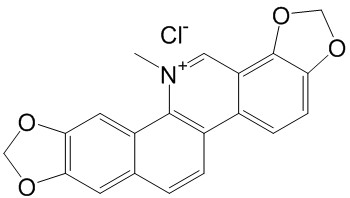Home
Products
Sanguinarine chloride



| Product Name | Sanguinarine chloride |
| Price: | $77 / 20mg |
| Catalog No.: | CN00792 |
| CAS No.: | 5578-73-4 |
| Molecular Formula: | C20H14NO4.Cl |
| Molecular Weight: | 367.79 g/mol |
| Purity: | >=98% |
| Type of Compound: | Alkaloids |
| Physical Desc.: | Powder |
| Source: | The herbs of Chelidonium majus. |
| Solvent: | Chloroform, Dichloromethane, Ethyl Acetate, DMSO, Acetone, etc. |
| SMILES: | C[n+]1cc2c3OCOc3ccc2c2c1c1cc3OCOc3cc1cc2.[Cl-] |
| Contact us | |
|---|---|
| First Name: | |
| Last Name: | |
| E-mail: | |
| Question: | |
| Description | Sanguinarine chloride, a benzophenanthridine alkaloid derived from the root of Sanguinaria Canadensis, can stimulate apoptosis via activating the production of reactive oxygen species (ROS). Sanguinarine-induced apoptosis is associated with the activation of JNK and NF-κB. |
| Target | Apoptosis[1] |
| In Vitro | Sanguinarine (SANG)-induced apoptosis is associated with the activation of JNK and NF-κB signal pathways.To determine the effects of Sanguinarine on cell viability, 22B-cFluc cells are stimulated with different concentrations of Sanguinarine for 24 h, and then a CKK-8 assay is performed. The treatment with Sanguinarine decreases the proliferation of 22B cells in a dose-dependent manner. Meanwhile, the cytosolic extracts of 22B-cFluc cells treated with different dose of Sanguinarine are measured to detect cellular caspase-3 activity using Ac-DEVD-pNA, which is a validated caspase-3 substrate. The absorbance at 450 nm increases in a dose-dependent manner, indicating increased caspase-3 activity stimulated by Sanguinarine[1]. |
| In Vivo | To evaluate the apoptosis induced by Sanguinarine (SANG) in vivo, 22B-cFluc cells are inoculated subcutaneously into one flank of nude mice and xenograft models are allowed to establish. Mice are treated intravenously with 10 mg/kg of Sanguinarine. At 24, 48 and 72 h after treatment, bioluminescent imaging is performed after i.p. injection of mice with 150 mg/kg of D-luciferin substrate. Sanguinarine treatment induces an obvious increase of luminescent signal as early as 48 h after initial treatment. A sustained bioluminescent imaging (BLI) intensity increased is observed throughout the course of experiment. At 72 h after treatment, the tumors are collected and subjected to TUNEL staining for evaluating apoptosis. Compared with the control tumors, the group treated with Sanguinarine exhibits significantly more cell apoptosis, indicated by the increased green signals from the sporadic apoptotic cells[1]. |
| Cell Assay | The cell viability of Sanguinarine is determined by CCK-8 assay using a cell counting kit-8. Briefly, 22B-cFluc cells are seeded in a 96-well plate (5×103 cells/well) and treated with different concentrations of Sanguinarine (0.5 μM, 1 μM, 2 μM, 4 μM) for 24 h. Then 10 mL CKK-8 is added to each well for 4 h and the absorbance at 450 nm is measured with a microplate reader. The optical density (OD) values are determined to reflect the viable cell populations from each well[1]. |
| Animal Admin | Mice[1] Xenografted tumor models are prepared by injection of 1×107 22B-cFluc cells suspended in PBS into nude mouse (n=6). After tumors reach a volume of approximately 100 mm3, Sanguinarine (10 mg/kg) is i.v. injected into mice. After injection for 24 h, 48 h and 72 h, mice are given a single i.p. dose of 150 mg/kg D-luciferin and bioluminescence imaging are performed using a Xenogen Lumina II system. The signal intensity in the region of interest is expressed using the Living Image software 4.1. For the anti-tumor therapy studies, one group of tumor-bearing mice (n=6) receive intravenously 10 mg/kg of Sanguinarine every other day throughout the experimental period, while the control group of mice (n=6) receive DMSO only. Tumor growth measurement is calculated[1]. |
| Exact Mass | 367.061127 |
| PSA | 40.80000 |
| LogP | 0.43210 |
| Storage condition | Store at +4°C |